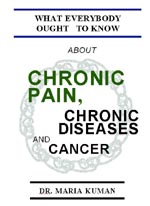
E
verybody needs to know about chronic pain, chronic diseases, and cancer because chronic diseases caused 70% of the deaths in 2010, and only cancer and heart disease accounted for 48% of them. More than 100 millions adult Americans suffer from chronic pain and more than 117 millions suffer from one or more chronic diseases. It costs the nation 635 billions per year. This book reveals the nature of chronic pain and chronic diseases and is equally useful for the sufferers and their doctors by teaching them what chronic pain and chronic diseases are and how to deal with them.

While our modern medicine is very powerful in the treatment of acute diseases caused by viruses or bacteria, the only treatment it offers for chronic pain is painkillers for temporary pain relief. This book offers local treatment for chronic pain, which combined with the drug for pain relief will substantially increase the efficiency of the treatment.
The book explains how strong or prolonged stress leads to chronic diseases. It create large delays, for which the body cannot compensate, and this destroys beyond repair the time synchrony of the biorhythms in the genetically weak organ, which leads to functional (chronic) disease of the organ. The only way to restore the lost harmony, and thus cure the chronic disease, is a series of acupuncture treatments, which by adding energy to the body bring back the state of health.
The book also explains the relationship of stress to cancer, which in its last stage of malignancy is jumbled mass of cells multiplying senselessly, instead of forming useful architecture. Therefore, cancer is a destroyed beyond repair structural organization of the cells. The damage is done by the electrically charged neurotransmitters released during stress.
The author uses the nonequilibrium theory of Prigogine to explain why the cure of chronic diseases and cancer is slow, difficult and unpredictable by nature, and why the best approach to them would be early diagnosis and prevention with early acupuncture treatment. Lyapounov criteria for stability were used to determine the limits of health stability under stress.
“I
was impressed by the author's original view on chronic diseases and cancer and I asked her how she came to see things this way. She told me through many years of measurements, but she couldn't write about this in the book because they wouldn't give her a patent for the equipment. It is a very interesting book and I think the future will prove her right.”
Dr. Alvin Weinberg,
Ex-Director of ORNL
